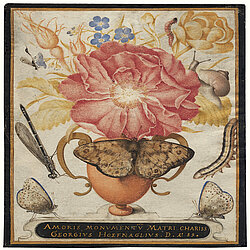Loading the page ...
Joris Hoefnagel
1542 Antwerp – 1600 Vienna
Joris Hoefnagels eventful biography casts a fascinating light on the history of European art and culture in the second half of the 16th century. He must have been a cosmopolitan and widely educated person. Hoefnagel came from a prosperous Antwerp family and soon undertook trips to France, Spain and, probably, England as well. The drawings and sketches accumulated during his travels were later to form the basis of the urban chronicle Civitates orbis terrarum published by Braun and Hogenberg in Cologne between 1572 and 1618. Following the sack of Antwerp by the Spaniards in 1576 Hoefnagel, who had embraced Calvinism, was forced to leave the town penniless. After a stay in Augsburg, where he worked for the Fugger family, and a trip to Italy he finally arrived in Munich in 1578. His fame spread quickly, for Hoefnagel not only worked for Duke Albrecht V of Bavaria and his successor Wilhelm V, but also created one of his main works, the sumptuous and lavishly illustrated Missale Romanum (Vienna, Österreichische Nationalbibliothek), as a commission for Archduke Ferdinand of Tyrol between 1581 and 1590. This artistic feat led to his appointment to the Imperial Court in Vienna and Prague, where in the 1590s he produced further masterpieces for Rudolph II.
Archive
